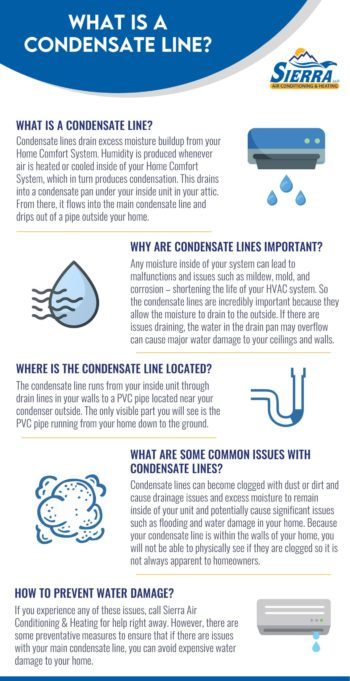What is a Condensate Line?
Condensate lines drain excess moisture buildup from your Home Comfort System. Humidity is produced whenever air is heated or cooled inside of your Home Comfort System, which in turn produces condensation. This drains into a condensate pan under your inside unit in your attic. From there, it flows into the main condensate line and drips out of a pipe outside your home. When you see dripping from the condensate lines outside of your home, it means that your system is functioning properly.
There is also a secondary, backup condensate drain line that usually will drain above a door or window. At the indoor unit, there is also a secondary drain pan that connects to the secondary condensate drain line. If there is an issue with the primary condensate line, the secondary acts as a backup to help avoid water damage.
Why Are Condensate Lines Important?
Any moisture inside of your system can lead to malfunctions and issues such as mildew, mold, and corrosion – shortening the life of your HVAC system. So the condensate lines are incredibly important because they allow the moisture to drain to the outside. If there are issues draining, the water in the drain pan may overflow can cause major water damage to your ceilings and walls.
Where is The Condensate Line Located?
The condensate line runs from your inside unit through drain lines in your walls to a PVC pipe located near your condenser outside. The only visible part you will see is the PVC pipe running from your home down to the ground.
What Are Some Common Issues With Condensate Lines?
Condensate lines can become clogged with dust or dirt and cause drainage issues and excess moisture to remain inside of your unit and potentially cause significant issues such as flooding and water damage in your home. Because your condensate line is within the walls of your home, you will not be able to physically see if they are clogged so it is not always apparent to homeowners. A few signs of clogged condensate lines include water leaking from your ceiling or attic, stained ceilings or walls, excess humidity in your home, unpleasant moldy odors, or issues with your air conditioner shutting off and not turning back on.
How to Prevent Water Damage?
If you experience any of these issues, call Sierra Air Conditioning & Plumbing for help right away. However, there are some preventative measures to ensure that if there are issues with your main condensate line, you can avoid expensive water damage to your home.
Ceiling Saver Kits are placed inside of the secondary drain pan. Once it senses any water, it will automatically disable your Home Comfort System to prevent any water from spilling and overflowing. If you would like to learn more, call us today!




